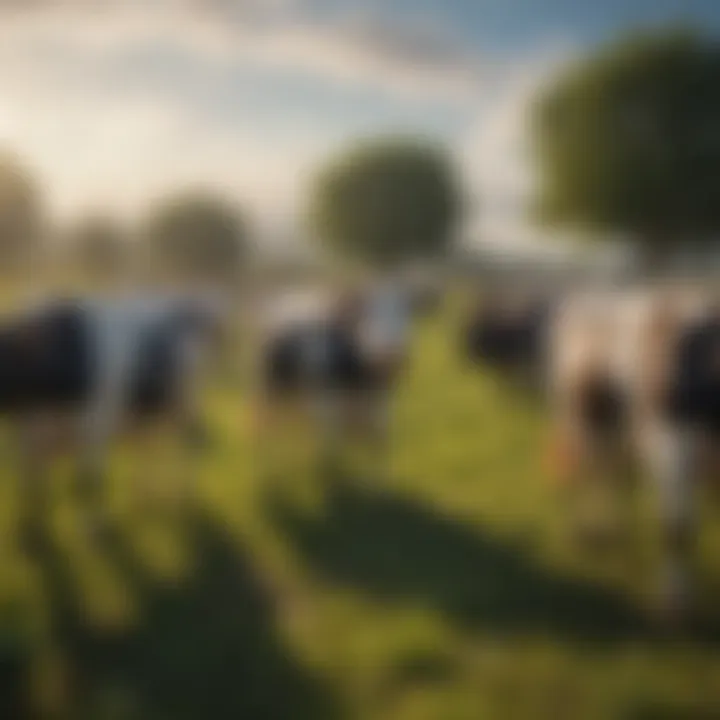Exploring Food with Dairy: Culinary and Nutritional Insights


Topic Overview
Definition and Importance
Dairy products are derived from the milk of mammals. Common sources include cows, goats, and sheep. Dairy plays a crucial role in the human diet, offering essential nutrients like calcium, protein, and vitamins. Beyond nutrition, dairy is integral to various culinary traditions worldwide. It provides texture and flavor to dishes ranging from creamy sauces to rich desserts.
Brief History and Evolution
The history of dairy consumption can be traced back thousands of years. Evidence suggests that humans began domesticating livestock for milk around 9000 BCE. As societies evolved, so did dairy practices. Techniques for processing and preserving milk, such as fermentation and curdling, emerged, leading to a variety of products like cheese and yogurt. Different cultures adapted dairy in unique ways, resulting in a rich tapestry of flavors and preparations.
Key Techniques and Innovations
Sustainable Farming Practices
Sustainable practices in dairy farming are increasingly important. Farmers now emphasize animal welfare and environmental stewardship. Techniques include rotational grazing, which allows pasture recovery and enhances soil quality. Furthermore, integrated pest management reduces the reliance on harmful chemicals, promoting biodiversity.
Advanced Agronomic Technologies
Technological innovations are transforming dairy farming. Precision agriculture tools enable farmers to monitor soil health and crop conditions with accuracy. Automated milking systems increase efficiency while maintaining high animal welfare standards. Data analytics assists in optimizing feed, which directly impacts milk production and quality.
Practical Applications
Step-by-Step Guides
- Selecting the Right Breed: Choose a dairy breed that aligns with your production goals. Consider factors like milk yield, fat content, and adaptability to local climate.
- Implementing Sustainable Practices: Adopting sustainable farming techniques can enhance yield and reduce environmental impact.
- Utilizing Technology: Invest in smart farming technology to monitor herd health and optimize feeding regimes.
Case Studies or Real-World Examples
The case of Organic Valley, a cooperative of organic farmers in the U.S., illustrates successful sustainable practices. They prioritize animal welfare and environmental health while producing high-quality organic dairy products.
"Sustainable dairy farming not only meets consumer demand for ethical products but also fosters a healthier planet."
By understanding and applying the insights in dairy farming and dairy product utilization, enthusiasts and farmers can navigate and contribute to a system that is both sustainable and innovative.
Prelims to Dairy in Food
Dairy foods are fundamental components of many diets across the globe. This section delves into the significance of dairy in culinary practices and nutrition, highlighting various benefits and considerations.
First, it is essential to understand what dairy is. Dairy products are derived from the milk of mammals, such as cows, goats, and sheep. They include a wide variety of items like milk, cheese, yogurt, and butter. The diversity in dairy foods adds richness to diets, benefiting both taste and health.
One of the key advantages of including dairy in food is its nutritional value. Dairy products are rich in calcium, vitamin D, protein, and other vital nutrients.
Key points include:
- Calcium and Bone Health: Dairy is a primary source of calcium, which is essential for bone development and preventing osteoporosis.
- Protein Content: Dairy offers high-quality protein, which supports muscle growth and repair.
- Versatility in Cooking: Dairy enhances flavor and texture in countless recipes, making it a staple in various cuisines.
However, there are considerations to keep in mind. For some individuals, lactose intolerance poses a challenge, as they cannot effectively digest lactose, a sugar found in milk. This condition highlights the need for awareness about dairy consumption, as not all individuals can benefit equally.
Moreover, the environmental aspects of dairy farming are increasingly coming under scrutiny. Concerns about sustainability and animal welfare are prompting discussions about alternative sources of nutrition.
"Dairy is not just a food group; it embodies cultural traditions, sustainability debates, and nutritional debates that warrent thorough understanding."
In summary, the introduction to dairy in food sets the stage for a deeper exploration of its historical roots, nutritional profile, and culinary applications. This section establishes the importance of dairy, not only from a culinary perspective but also considering health implications and sustainability concerns.
Historical Context of Dairy Consumption
Understanding the historical context of dairy consumption reveals much about its role in human civilization. Dairy products have been a significant source of nutrition for various cultures. The domestication of animals such as cows, goats, and sheep laid the foundation for dairy farming about 10,000 years ago. As humans began to settle, they discovered that milk could provide vital nutrients. This transition marked a crucial change in human diets, allowing for population growth and increased agricultural practices.
Dairy products not only provided sustenance, but they also played an essential role in trade and cultural exchanges. Different regions developed unique dairy products based on their environmental conditions and cultural preferences, influencing societies and economies. Examining these historical elements helps recognize the benefits of dairy consumption and its impact across different eras.
Ancient Practices
In ancient societies, dairy served essential purposes. Evidence shows that many civilizations, such as the Sumerians, Egyptians, and Mongols, relied on milk and its derivatives. For instance, Sumerians were known to have made cheese over 5,000 years ago. Sheep and goats were commonly farmed for their milk in various regions, which contributed to both food security and economic stability.
These ancient practices not only represented a dietary source but also held religious significance. Many cultures revered dairy animals and associated them with fertility and prosperity. This deep connection illustrates how dairy consumption is rooted deeply in human culture. The potential of milk to be transformed into various products, including cheese and yogurt, further exemplified the ingenuity of ancient peoples.
Evolution Through Cultures
Cultural evolution has shaped and diversified dairy consumption throughout history. For example, the introduction of fermentation processes allowed various societies to create distinct dairy products. In Europe, cultures led by the Romans began to develop more refined cheese-making techniques. Meanwhile, in Asia, yogurt became a staple due to its probiotic benefits.
As trade routes expanded, the exchange of dairy knowledge and products occurred. This interaction allowed for the proliferation of unique dairy items like ghee in India, Roquefort in France, and kefir in the Caucasus. These innovations continue to influence global culinary practices today.
- The impact of dairy consumption on societies includes:
- Nutritional sustenance
- Economic development through trade
- Cultural exchanges and practices
Dairy has retained a prominent place in modern diets. Understanding its historical context enables a deeper appreciation of its significance today. The interplay of ancient practices and cultural evolution illustrates the complexity of dairy's role in the global food system.
Types of Dairy Foods
The section on Types of Dairy Foods plays a crucial role in understanding the broad scope that dairy covers in our diets and cuisines. By elucidating different categories of dairy products, we can appreciate not only their nutritional offerings but also their culinary versatility. Dairy foods are integral to many meals and snacks worldwide, and knowing the various forms can help consumers make informed choices.
Milk Varieties
Milk serves as the foundational component of most dairy foods. There are diverse milk varieties available today, each with unique characteristics and benefits. Cow's milk is the most commonly consumed type globally. However, goat's milk and sheep's milk have gained popularity due to their distinctive flavors and higher nutrient density.
For instance, goat's milk is often better tolerated by those with certain lactose sensitivities, and it contains higher levels of some vitamins and minerals than cow's milk. Additionally, there are plant-based alternatives such as almond, soy, and oat milk. While not technically dairy, these products provide options for those with dietary restrictions or preferences.
Cheese Categories


Cheese, a product derived from milk, showcases the richness and variety of dairy foods. It can be broadly classified into several categories, including fresh, aged, soft, and hard cheeses. Each type of cheese carries unique textures and flavors, influenced by factors such as the milk used, processing methods, and aging time.
For example, mozzarella and ricotta are fresh cheeses that are typically soft and mild, making them popular in Italian dishes. Hard cheeses like cheddar and parmesan are aged, resulting in more robust flavors suitable for grating and adding depth to meals.
"Cheese not only enhances flavor but also provides a range of nutrients including protein and calcium."
Yogurt and Fermented Products
Yogurt represents another vital category of dairy foods, prized for its probiotic properties and health benefits. Traditional yogurt is made by fermenting milk with specific bacterial cultures, which contributes to its tangy flavor and creamy texture. The fermentation process not only aids in digestion but also enriches yogurt with beneficial bacteria known as probiotics.
Beyond standard yogurt, there are also specialized versions like Greek yogurt, which is thicker and higher in protein. Additionally, kefir is a fermented product similar to yogurt but with a more liquid consistency and a slightly effervescent quality. These options offer versatility, whether consumed as a snack or incorporated into recipes.
Each type of dairy product creates opportunities for culinary innovation, from savory to sweet dishes. Understanding these variations helps consumers optimize their diets while enjoying the nuances of flavors and textures that dairy foods offer. By exploring the spectrum of dairy foods, we unlock the potential for a more enriching culinary experience.
Nutritional Profile of Dairy
Understanding the nutritional profile of dairy products is crucial for anyone interested in the health implications and culinary applications of these foods. Dairy serves as a dense source of essential vitamins, minerals, and proteins. Regular consumption of dairy can contribute to fulfilling daily nutrient requirements for many groups of people. However, it is also important to be aware of both the benefits and potential risks associated with dairy intake.
Vitamins and Minerals
Dairy products are rich in several vital nutrients. Among them, calcium stands out as a key mineral. It is essential for bone health and plays a role in muscle function. An adequate intake of calcium helps prevent osteoporosis later in life.
Other important vitamins found in dairy include vitamin D, which assists in calcium absorption, and vitamin B12, necessary for red blood cell formation. Dairy also contains phosphorus, potassium, and riboflavin, each contributing to various bodily functions.
In summary, dairy products are a powerhouse of nutrients that can support overall health. They provide an easy way for individuals to meet their nutritional needs, especially for those who include dairy in their diets on a regular basis.
Health Benefits
The health benefits associated with dairy consumption are manifold. For many, the most notable benefit is the contribution to bone density. Calcium and vitamin D work together to strengthen bones, reducing the risk of fractures and degenerative conditions related to aging.
Furthermore, dairy may support muscle maintenance. The protein found in dairy products aids in muscle repair and growth, which is particularly beneficial for active individuals and athletes.
Additionally, some studies suggest that full-fat dairy may be linked to a lower risk of obesity and heart disease. This paradox has led to ongoing research on the role of fat in dairy and its impacts on health. The complex nature of dairy's effects on health makes it a compelling subject for anyone interested in nutrition.
Potential Health Risks
While dairy provides many essential nutrients, it also comes with potential risks. Chief among these is lactose intolerance, a widespread condition affecting a significant portion of the population. Individuals with lactose intolerance may experience gastrointestinal discomfort when consuming traditional dairy products due to the inability to properly digest lactose. This has important implications for dietary choices, as alternatives may be necessary for comfort and health.
Moreover, some studies have associated high consumption of dairy with increased health risks, such as certain types of cancer. The evidence is not definitive, but it underscores the importance of moderation in dairy intake.
Lastly, the source of dairy can influence health outcomes. Non-organic dairy may contain hormones and antibiotics, raising concerns about their long-term health effects.
In summary, while dairy products offer substantial nutritional benefits, being aware of their potential risks is essential for making informed dietary choices.
Culinary Applications of Dairy
Culinary applications of dairy encompass a broad spectrum of uses that extend beyond mere taste. Dairy ingredients play a crucial role in the texture, flavor, and nutritional value of many recipes. The versatility of dairy products allows them to enhance a wide range of dishes, from appetizers to desserts.
Incorporating dairy into cooking also offers various health benefits. Nutritionally, dairy foods are rich in calcium, protein, and essential vitamins. These factors make dairy a fundamental component of numerous diets worldwide. Understanding how to utilize dairy effectively can elevate culinary practices and contribute to a healthier lifestyle.
Dairy in Traditional Dishes
Dairy has been a staple in traditional dishes across many cultures. In Italian cuisine, creamy sauces made from Parmesan cheese or ricotta enhance pasta dishes. In Indian cooking, yogurt is used as a base for marinades and sauces. Tzatziki, a Greek sauce made from yogurt, adds a refreshing element to grilled meats.
Each region's use of dairy reflects its unique climate, history, and available resources. The incorporation of dairy into national cuisines often signifies family gatherings and celebratory events. Dairy not only adds flavor; it often symbolizes hospitality and community sharing.
Moreover, traditional dishes prepare using dairy bring forth the rich history of culinary expertise and authentic flavors. For instance, qori, a Polish cheese, plays an integral role in holiday recipes, while kefir in Russian culture is used for both culinary and medicinal purposes.
Innovative Dairy Recipes
Innovation in dairy recipes manifests in creative uses of traditional ingredients. One example is cauliflower cheese, where classic cheese sauce is combined with roasted cauliflower to create a healthier side dish. Another example includes using cottage cheese in smoothie recipes, offering a protein boost to breakfast.
Experimenting with flavors and techniques can lead to unique dishes. For instance, creating gourmet mac and cheese by adding gourmet cheeses like Gruyère or Fontina can transform a simple recipe into something exceptional.
Additionally, lactose-free options like almond milk cheese can accommodate dietary restrictions while still allowing for creativity in the kitchen.
Dairy Processing Techniques
Dairy processing techniques play a crucial role in ensuring the safety and quality of dairy products. They transform raw milk into various consumable forms. Understanding these processes is essential for farmers and consumers alike. These techniques not only extend shelf life but also enhance nutritional value and flavor. Products like cheese, yogurt, and skim milk result from specialized processing methods. Thus, exploring these techniques provides insights into dairy’s multifaceted nature.
Pasteurization and Homogenization
Pasteurization is a heat treatment that kills harmful bacteria in milk and dairy products. This technique is named after Louis Pasteur, who developed it in the 19th century. The process involves heating milk to a specific temperature for a set period of time. For example, milk is often heated to 72°C for 15 seconds in high-temperature short-time pasteurization. This method preserves the quality and extends the shelf life of dairy products.
Homogenization, on the other hand, is a mechanical process that breaks down fat molecules in milk. This prevents cream from separating and gives milk a uniform consistency. Homogenized milk has a smoother texture and is preferred by many consumers. The process also improves digestibility, making it easier for the body to absorb nutrients.
Together, pasteurization and homogenization have significantly improved dairy safety and consumption experience worldwide.
"Pasteurization and homogenization are pivotal in making dairy products safe and enjoyable for all consumers."
Cheese Production Methods
Cheese production is an art that involves several steps, each crucial in developing the final product. The primary ingredients used are milk, cultures, and rennet. The process begins with curdling, where rennet and bacteria are added to warm milk. This causes the milk to separate into curds and whey. After this separation, the curds are drained and pressed into molds, shaping them into various cheese forms.
Next, the cheese goes through maturation or aging. This step can last from a few days to several years, depending on the type of cheese being produced. During maturation, enzymes and bacteria develop the cheese’s flavor and texture. Different cheese varieties, such as hard cheeses like Cheddar and soft cheeses like Brie, result from specific production techniques and aging processes.
Key Aspects of Cheese Production
- Type of milk used (cow, goat, sheep)
- Heat treatment during curdling
- Length and conditions of aging
These factors create distinct flavors and characteristics. Therefore, cheese production is a complex field that requires knowledge, skill, and an understanding of dairy science.


Dairy Alternatives in Modern Diets
As our understanding of nutrition evolves, the interest in dairy alternatives is on the rise. This shift has been driven by various factors including plant-based diets, health consciousness, and concerns about animal welfare. In this section, we will explore the types of dairy alternatives available, their benefits, and the considerations that one should keep in mind when integrating them into a diet.
Plant-Based Alternatives
Plant-based dairy alternatives have gained significant popularity. These products mimic the taste and texture of traditional dairy while being derived from plants. Common sources for these alternatives include almonds, soy, oats, and coconuts. For instance, almond milk is made from ground almonds and water. Soy milk is produced by soaking, grinding, boiling, and filtering soybeans. These alternatives can suit a variety of dietary needs, including lactose intolerance and veganism.
The benefits of plant-based alternatives are noteworthy. They often contain less saturated fat than dairy and can be lower in calories. Many also come fortified with calcium and vitamins like B12, although nutrient profiles can vary widely between products. Choosing fortified alternatives can help prevent deficiencies while enjoying the taste and versatility.
One downside to consider is that some plant-based alternatives can have added sugars and preservatives. Therefore, scrutinizing labels for added ingredients is crucial.
Nutritional Comparisons
When comparing dairy to its plant-based counterparts, understanding the nutritional content is essential. Dairy products, like cow's milk, are rich in protein, calcium, and vitamin D. Each serving typically contains around 8 grams of protein, a crucial macronutrient for muscle health and repair. The calcium found in dairy is vital for bone health. However, recent trends in the plant-based segment show that alternatives are making strides in this area.
For example, soy milk provides close to the same protein content as cow's milk. Almond milk, while lower in protein, can be enriched with calcium and vitamin D to match dairy sources. The following points structure the comparison:
- Protein Content: Soy-based alternatives are high in protein, whereas almond and coconut sources are lower.
- Fat Content: Dairy tends to be higher in saturated fats, while plant-based options often favor healthier unsaturated fats.
- Calcium Levels: Many plant-based options are fortified, but it is important to verify each brand's nutritional makeup.
In summary, while dairy remains a convenient source of nutrition for many, plant-based alternatives offer a viable and sometimes healthier option. They align well with modern dietary preferences and values, making them worth considering in any balanced diet.
Environmental Considerations of Dairy Farming
Dairy farming plays a critical role in global food production. However, it also poses significant environmental challenges that require urgent attention. These challenges include greenhouse gas emissions, water consumption, and land use. The environmental footprint of dairy farms impacts both local ecosystems and global climate patterns. Understanding these factors is essential for farmers, policymakers, and consumers alike.
Sustainability Challenges
Dairy farming confronts numerous sustainability challenges. One of the foremost issues is the emission of greenhouse gases, primarily methane, which is produced during digestion in ruminants. Methane has a global warming potential significantly higher than that of carbon dioxide, creating urgency for mitigation strategies.
Another challenge is water usage. Dairy production is water-intensive. It involves supplying water for cows and managing water for crops that feed them. In arid regions, this can lead to unsustainable depletion of water resources.
Moreover, land use for feed production contributes to deforestation and biodiversity loss. As the demand for dairy increases, the pressure on land resources intensifies, leading to potential conflict between agricultural expansion and conservation efforts.
Strategies are required to address these challenges. This includes optimizing feed efficiency to reduce methane emissions and managing manure to capture and recycle nutrients.
"The environmental impact of dairy farming is significant, requiring innovative solutions to ensure sustainability."
Innovative Practices in Dairy Farming
Innovative practices in dairy farming offer pathways towards sustainability. One notable practice is the implementation of precision farming techniques. These involve using technology to monitor animal health and optimize feed use. This not only enhances productivity but also minimizes waste and resource consumption.
Additionally, adopting rotational grazing methods can improve land management. By allowing pasturelands to rest and regenerate, farmers can enhance soil health and reduce the need for chemical fertilizers. This approach fosters a more resilient farming system.
Utilization of biogas systems also presents an opportunity for waste management. By converting manure into biogas, farmers can generate energy while reducing methane emissions. This dual benefit not only supports energy independence but also contributes to a circular economy.
Lastly, considering integrated crop-livestock systems can yield substantial ecological benefits. By integrating dairy cattle with crop production, nutrient cycling can be optimized, reducing reliance on external inputs.
These innovative practices illustrate that it is possible to combine dairy farming with environmental sustainability, making significant strides toward a more responsible and ethical food system.
Cultural Significance of Dairy in Food
Dairy holds a notable position in various culinary traditions across the globe. It is more than just a source of nutrition; dairy products are imbued with cultural significance that reflects regional identities and historical practices. From milk to cheese and yogurt, each dairy product carries unique meanings that resonate with local customs and lifestyles. Understanding these cultural nuances can enrich our appreciation of dairy in food.
Regional Variations
Dairy consumption varies significantly from one region to another. In northern European countries like Sweden and Finland, dairy products such as milk and cheese play a central role in daily diets. The love for dairy has led to innovations like skyr in Iceland, a thick yogurt with deep cultural roots. Southern regions, like Mediterranean countries, often emphasize the use of dairy in cooking. For example, feta cheese and yogurt are staples in Greek cuisine, used in various dishes that define the cultural identity of the area.
Conversely, in Asia, particularly in regions like India, dairy is intertwined with religious and cultural practices. The consumption of dairy is prevalent in the form of ghee, paneer, and yogurt. These products are essential in culinary traditions and are often used in rituals and festivals, showcasing the profound respect for dairy.
The differences in dairy use reflect not only local agricultural practices but also the socio-economic and environmental factors influencing food culture. Each region illustrates unique dairy practices, which enhances our understanding of cultural identities rooted in their food systems.
Dairy in Festivals and Traditions
Dairy is also a fundamental ingredient in various festivals and traditions around the world. In many cultures, dairy is involved in celebrations and rituals that highlight its significance. For instance, in India, the festival of Janmashtami celebrates the birth of Lord Krishna, a deity associated with butter and milk. During this time, people prepare various dairy-based sweets and dishes, symbolizing the joy and abundance of dairy.
In Western cultures, dairy products often find their way into holiday meals. Cheese plates are a common feature during Christmas or Thanksgiving, symbolizing gathering and celebration. In some regions, special cheese or dairy products are crafted specifically for festive occasions, further emphasizing the role of dairy in communal celebrations.
The inclusion of dairy in these customs reflects its importance beyond just nourishment; it embodies heritage, community bonding, and cultural continuity. As societies evolve, these traditions adapt and influence modern culinary practices, showcasing dairy's enduring role in cultural narratives.
Dairy thus serves as a lens through which we can explore and appreciate cultural diversity in food practices. It highlights how food connects people to their roots and shapes identities across generations.
Consumer Trends Affecting Dairy Products
Understanding consumer trends is pivotal for stakeholders in the dairy industry. These trends shape not only production methods but also marketing strategies and product offerings. Consumers today are more informed and health-conscious than previous generations, which raises the importance of adapting to their changing preferences. Shifts in demand and health-focused choices play a significant role in how dairy products are perceived and consumed. This section elucidates these trends, emphasizing their implications for dairy farmers and manufacturers.
Shifts in Demand
Demand for dairy products has fluctuated considerably over recent years. Younger consumers are leaning more towards convenience and plant-based options. The rise of wellness culture also impacts this trend, as people explore lactose-free and alternative dairy products. Market research indicates that sales of almond milk and oat milk are increasing, signifying these demand shifts.
- Factors Influencing Demand Changes:
- Demographic shifts, like increasing numbers of lactose-intolerant individuals.
- The grab-and-go lifestyle, increasing the need for easy-to-consume products.
- Availability of diverse alternatives meeting dietary restrictions.
This transition underscores a crucial need for traditional dairy providers to innovate, ensuring traditional products remain relevant.
Health-Conscious Choices
As health awareness rises, consumers scrutinize nutritional labels more than ever. Dairy's role is under constant review, with people keen on understanding its benefits and possible drawbacks. Consumers are seeking products with clear, transparent ingredients.


Dairy products that emphasize low-fat, probiotic-rich options are gaining traction. The belief that dairy can contribute to gut health, bone strength, and overall nutrition drives individuals to explore these choices. Moreover, awareness of added sugars and artificial ingredients shapes purchases.
- Key Considerations for Health-Conscious Consumers:
- Seeking out organic and natural dairy options.
- Choosing products with higher protein content and fewer additives.
- Exploring alternatives that promise lowered allergenic properties, like lactose-free products.
"The dairy market must adapt to the informed choices of consumers who prioritize health and sustainability alongside taste."
Recognizing these health-focused trends could guide dairy producers in aligning their offerings with consumer needs, thereby enhancing customer loyalty and market presence.
Scientific Research on Dairy
Scientific research on dairy plays a crucial role in understanding its impact on human health, nutrition, and agriculture. The increasing interest in the nutritional benefits of dairy can be attributed to its rich composition of essential nutrients, including calcium, vitamin D, and protein. Studies in this domain provide insight into the balance of dairy consumption and its correlations with various health outcomes.
While dairy has long been part of the human diet, modern research digs deeper to explore its effects on bodily functions and disease prevention. It is important to assess the full range of findings, from positive impacts on bone health to potential drawbacks for those with lactose intolerance.
This section will cover the latest findings that shed light on dairy's role in nutrition and health, reflecting a commitment to evidence-based practices in agriculture and dietary guidelines.
Recent Studies
Recent studies have unearthed diverse results about dairy consumption. According to various research conducted within the last few years:
- Bone Health: Dairy products, enriched with calcium and vitamin D, are associated with improved bone density. A systematic review published in the Journal of Bone and Mineral Research suggests a clear correlation between dairy intake and reduced risk of osteoporosis in adults.
- Heart Health: A study in the American Journal of Clinical Nutrition examined full-fat dairy products. Findings indicated that moderate consumption does not increase cardiovascular risk, challenging previous assumptions that linked full-fat dairy with heart disease.
- Weight Management: Research has shown that dairy protein promotes satiety. This can aid in weight management by reducing overall caloric intake. A study published in Obesity Reviews supports this theory, linking dairy consumption with lower obesity rates globally.
These studies provide significant insights into the role of dairy in diets, helping inform both consumers and producers alike.
Controversies and Debates
The realm of dairy research is not without its controversies. Various debates surrounding dairy consumption continue to captivate both scientists and the general public. Key debates include:
- Lactose Intolerance: As more people identify as lactose intolerant, the question arises about dairy’s suitability in modern diets. Some argue for the endorsement of lactose-free products while others emphasize the role of fermented dairy in easing symptoms for those affected.
- Hormonal Concerns: Discussions about the presence of hormones in dairy farming practices often surface. Critics argue that these hormones could have adverse effects on human health, while proponents assert that regulated levels are safe for consumption.
- Environmental Impact: The resource-intensive nature of dairy farming raises ethical concerns. Critics often point to greenhouse gas emissions associated with dairy production. However, innovative practices are emerging, seeking to enhance sustainability without compromising dairy's nutritional benefits.
"The careful evaluation of dairy consumption, supported by ongoing research, will determine its future in our diets."
This examination of controversies illustrates the complexities involved in dairy research, emphasizing the necessity of balanced, informed perspectives in policy and dietary recommendations.
Dairy and Dietary Restrictions
Dairy consumption is a vital topic in discussions surrounding food, as it intersects with health, culture, and consumer behavior. Understanding dairy and dietary restrictions sheds light on how diverse populations manage their nutritional needs. This enables better decisions for both consumers and producers in a continuously evolving market.
Lactose Intolerance
Lactose intolerance is a common condition affecting a significant portion of the global population. It occurs when the body lacks sufficient lactase, an enzyme needed to digest lactose, the sugar found in milk and dairy products. The degree of intolerance varies, leading some individuals to experience mild discomfort while others suffer severe gastrointestinal distress.
- Symptoms of Lactose Intolerance:
- Bloating
- Diarrhea
- Gas and cramping
Addressing this condition often involves dietary adjustments. Many individuals turn to lactose-free alternatives or limit their dairy intake. It is crucial for those with lactose intolerance to ensure they still obtain necessary nutrients typically sourced from dairy. Alternatives like fortified soy or almond milk can provide adequate calcium and vitamin D.
Ultimately, understanding lactose intolerance guides farmers and producers to develop more inclusive dairy options, catering to a wider audience.
Veganism and Dairy-Free Lifestyles
The rise of veganism and dairy-free lifestyles reflects changing societal attitudes towards health, the environment and animal welfare. Individuals who adopt these lifestyles avoid all animal products, including dairy. This shift poses unique challenges and opportunities in the culinary landscape.
- Key considerations in dairy-free living:
- Nutritional balance: Ensuring intake of protein, calcium, and essential vitamins.
- Ethical concerns: Impact of factory farming on animal welfare and the environment.
- Environmental sustainability: Replacing dairy with plant-based options can reduce carbon footprints.
Dairy-free alternatives, such as coconut yogurt or cashew cheese, have become more prevalent in markets. This trend not only supports the needs of the vegan community but also attracts those with lactose intolerance or allergies. As the demand for dairy alternatives continues, more innovations in flavor and texture are likely, enriching the overall food experience for all consumers.
"The dairy industry must adapt to consumer preferences and health considerations to remain relevant in today's market."
A nuanced understanding of the diverse dietary restrictions regarding dairy helps inform both producers and consumers. As the conversation continues about health, ethics, and the environment, the pathway forward lies in creating inclusive food choices that respect individual needs.
Future Perspectives on Dairy Consumption
The future of dairy consumption is a critical topic that merits extensive exploration, particularly in the context of current global trends and challenges. As we move forward, several factors will shape the dairy industry, including consumer preferences, environmental pressures, and technological advancements. Understanding these elements is essential for farmers, policymakers, and consumers alike, as they navigate an evolving landscape that influences dietary choices and agricultural practices.
Emerging Trends
In recent years, dietary habits have experienced significant shifts, driven largely by increased awareness of health and sustainability. Consumers are leaning towards more plant-based diets, with a growing interest in products that are not only nutritious but also environmentally friendly. This trend raises questions about the role of traditional dairy products in modern diets.
- Plant-Based Alternatives: The rise of almond milk, oat milk, and soy yogurt reflects a broader willingness to seek alternatives to cow's milk. These products cater to those who are lactose intolerant or seeking to reduce their carbon footprint.
- Functional Dairy Products: There is also an emphasis on dairy that offers additional health benefits, such as probiotics in yogurt or fortified products with vitamins and minerals. Consumers increasingly desire foods that merge health with convenience.
- Ethical Considerations: The debate surrounding animal welfare and sustainable farming practices is becoming more pronounced. As people become more informed about farming conditions, they seek transparency from producers regarding ethical practices.
"The landscape of dairy consumption is changing, reflecting broader social attitudes towards health, sustainability, and ethical concerns."
Impact of Technology on Dairy Production
Technological advancements are revolutionizing dairy production in various ways. Innovations in this sector not only increase efficiency but also address sustainability and health concerns.
- Smart Farming: The incorporation of technology in farming methods has led to improved herd management. Tools such as sensors and data analytics enable farmers to monitor animal health and optimize milk production.
- Sustainable Practices: Technology aids in implementing sustainable practices, such as renewable energy sources within barns and waste management systems that convert manure into energy or fertilizers.
- Genetic Improvement: Advances in genetics allow for the breeding of cattle that produce higher milk yields while requiring fewer resources. This practice helps in reducing the environmental footprint of dairy farming.
As the dairy industry adapts to these technological changes, it is vital to consider the balance between innovation and traditional farming values. This ongoing evolution holds tremendous potential for the future of dairy consumption and production.
Finale
The conclusion of this article is fundamental as it encapsulates the entire discussion surrounding dairy in food. It is essential to reflect on the multifaceted roles that dairy products play in nutrition, culture, and environmental contexts.
Dairy consumption has a rich history and continues to evolve. With various milk varieties, cheese categories, and fermented products, the culinary applications of dairy are vast. Understanding these applications provides insight into culinary traditions across cultures and how dairy integrates into daily diets.
From a nutritional standpoint, dairy foods offer vital vitamins and minerals that contribute to a balanced diet. However, the benefits must be weighed against potential health risks for certain populations, such as those with lactose intolerance. It is crucial for consumers to be aware of their dietary needs and consider dairy alternatives, which are becoming increasingly popular.
Environmental considerations add another layer to the discussion. The sustainability challenges faced by dairy farming are pressing, yet innovations in practices can create pathways for environmentally friendly production.
In summary, the topic of dairy consumption is not just about food; it encompasses cultural significance, health implications, and sustainability. As consumers become more health-conscious and environmentally aware, the dairy industry must adapt to meet these changing demands. This article aims to provide clarity and awareness to farmers and enthusiasts alike, paving the way for informed decisions in both agricultural and culinary contexts.



